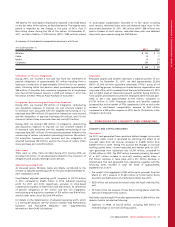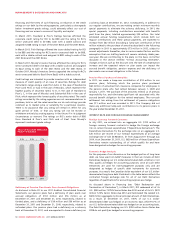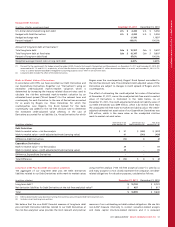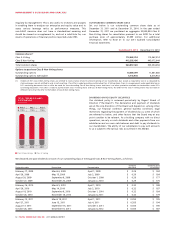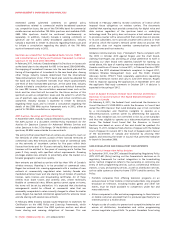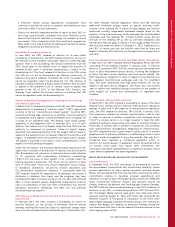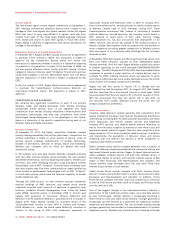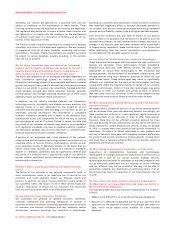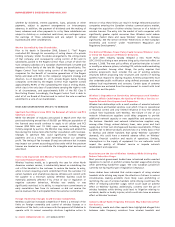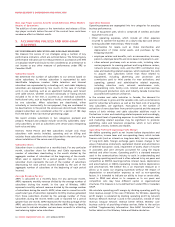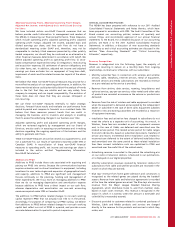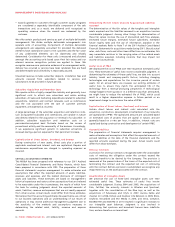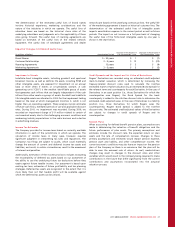Rogers 2011 Annual Report Download - page 61
Download and view the complete annual report
Please find page 61 of the 2011 Rogers annual report below. You can navigate through the pages in the report by either clicking on the pages listed below, or by using the keyword search tool below to find specific information within the annual report.
MANAGEMENT’S DISCUSSION AND ANALYSIS
a television service during negotiations, broadcasters must
continue to provide the service in question and distributors must
continue to offer it to their subscribers.
• Directs the vertically integrated entities to report by April 2012 on
how they have provided consumers with more flexibility in the
services that they can subscribe to through, for example, pick and
pay models. If the Commission finds that insufficient progress has
been made in this area a further proceeding will be held to impose
obligations to achieve the desired results.
New Media Proceeding Follow-up
In June 2009, the CRTC released its decision on its new media
proceeding. In that Decision, the CRTC rejected the notion of a tax on
ISP revenues to fund Canadian ‘webisodes’. Based on conflicting legal
opinions filed in the proceeding, the decision determined that the
CRTC would refer to the Federal Court of Appeal the question of
whether an ISP, when it distributes broadcasting, is subject to the
Broadcasting Act. The Court released its Decision in July 2010 ruling
that ISPs do not act as broadcasters by offering connectivity to
television and movie websites. Therefore the Court concluded they
cannot be regulated under the Broadcasting Act. The Alliance of
Canadian Cinema, Television & Radio Artists (“ACTRA”) filed for leave
to appeal to the Supreme Court of Canada. Leave to appeal was
granted in the fall of 2011. In the February 2012 Decision, the
Supreme Court upheld the previous decision concluding that ISPs
cannot be regulated under the Broadcasting Act.
Review of Broadcasting Regulations including Fee-for-Carriage
and Distant Signal Fees
In March 2010, in Broadcasting Decision 2010-167, the CRTC made the
determination to implement a “value for signal” (“VFS”) regime that
is similar to the U.S. “retransmission consent regime”. Since the CRTC
received conflicting legal opinions as to whether it has the authority
to implement such a regime, it asked the Federal Court of Appeal for
a ruling on an expedited basis. The Federal Court heard parties’
arguments in mid-September 2010. In February 2011, in a 2-1 split
decision, the Federal Court of Appeal ruled that the CRTC has the
authority to implement its proposed “value for signal” regime
described in Broadcasting Decision 2010-167. Rogers filed for leave to
appeal to the Supreme Court of Canada in May 2011 as did Telus and
Cogeco. In September 2011, the Supreme Court gave leave to appeal.
The appeal is expected to be heard in 2012. Implementation of the
regime is on hold pending the appeal.
Under this VFS regime, the proposed market-based negotiations will
apply only to licencees of private local TV stations, thus excluding the
CBC. Broadcasters will choose on a station-by-station basis whether
to: (1) negotiate with broadcasting distribution undertakings
(“BDU”s) for the value of their signals; or (2) continue under the
existing regulatory framework. This choice will be valid for a fixed
term of three years. Those who choose negotiation would forego:
(i) mandatory distribution; (ii) priority channel placement; and
(iii) simultaneous substitution. However, if unsuccessful after the
CRTC-imposed timeline for negotiations, broadcasters can require a
distributor to blackout their signal and the programs they have
purchased the rights to that are airing on U.S. (i.e. NBC, CBS, FOX and
ABC) or other Canadian services. Negotiated compensation could be
cash or a combination of cash and other consideration (e.g. channel
placement, promotion, marketing). The CRTC will only arbitrate
should both parties request it.
CRTC Review of Wholesale Internet Service Pricing and Usage-
based Billing
In February 2011, the CRTC initiated a proceeding to review its
previous decisions on the pricing of wholesale internet services
whereby reselling ISPs would be subject to additional charges when
their end-users exceeded specific bandwidth caps. In November 2011,
the CRTC released Telecom Regulatory Policy 2011-703 rejecting
additional wholesale charges based on specific end-user traffic
volumes of the reselling ISP. In place of these charges, the Decision
authorized monthly usage-based wholesale charges based on the
capacity of the interconnecting facility between the facilities-based
wholesaler and the reselling ISP. A fixed monthly access fee per
end-user of the reselling ISP as well as one-time installation and
maintenance fees will apply in addition to the usage charge. The new
rate structure came into effect on February 1, 2012. Applications to
the CRTC to review and vary the Decision were filed by Shaw and
Rogers in February 2012. Decisions on the applications are expected in
mid-2012.
Basic Telecommunications Services and Other Matters Proceeding
In May 2011, the CRTC released Telecom Regulatory Policy 2011-291
concluding the proceeding initiated in January 2010, in Telecom
Notice of Consultation CRTC 2010-43, reviewing issues associated with
access to basic telecommunications services, including the obligation
to serve, the basic service objective, and local service subsidy. The
CRTC retained an obligation to serve in regard to voice services only
for regulated (non-forborne) exchanges and only for incumbent
ILECs. The CRTC determined that high-speed Internet will not be
added to the basic service obligation. The Policy also took further
steps to reduce local subsidies through a reduction in the number of
areas eligible for subsidy and authorization of regulated rate
increases.
CRTC Network Interconnection Decision
In March 2011, the CRTC initiated a proceeding to review i) the three
separate local, wireless and toll network interconnection regulatory
regimes in place and ii) the need for IP interconnection regulatory
rules. The CRTC released its Decision, TRP 2012-24, in January 2012.
The Commission altered the wireless interconnection rules so that
in order to become a wireless competitive local exchange carrier
(“CLEC”) a wireless carrier is no longer required to meet the CLEC
obligations related to equal access and supply of directory listings to
other LECs. A wireless CLEC is entitled to shared-cost, bill and keep,
local interconnection arrangements. Regarding IP interconnection,
the CRTC determined that in areas where a carrier uses IP to transfer
telephone calls to either an affiliated or unaffiliated provider, it must
provide a similar arrangement to any other provider that asks for it.
Companies must negotiate a commercial agreement within six
months of a formal request. If agreement cannot be reached within
six months, either party may request CRTC intervention. The
Commission anticipates implementation or significant progress within
a year after an agreement has been negotiated.
MEDIA REGULATION AND REGULATORY DEVELOPMENTS
Licence Renewals
In December 2010, the CRTC announced its proceeding to consider
the group-based (conventional and discretionary specialty) licence
renewal applications of major media companies including Rogers
Media. This represented the first time the CRTC would impose licence
commitments relating to Canadian program expenditures and
exhibition on a group basis. The Rogers group includes the OMNI and
Citytv conventional television stations and specialty services G4
Canada, Outdoor Life Network and The Biography Channel (Canada).
The CRTC held the licence renewal hearing in April 2011 releasing its
decisions in July 2011. In Broadcasting Decisions 2011-441 and 2011-
447, the Rogers Media stations were given new three-year licence
renewals expiring August 31, 2014 with terms that recognized the
different situation of the group in comparison to the three other
large English-language Canadian broadcast groups. The Commission
expects that Rogers will develop its broadcast holdings during the
next three years such that it can be treated in the same manner as the
other large groups in 2014.
2011 ANNUAL REPORT ROGERS COMMUNICATIONS INC. 57


